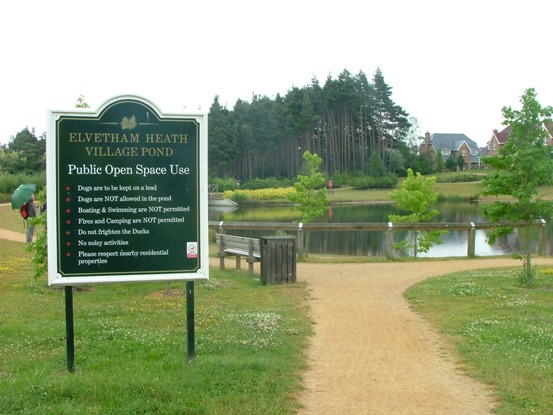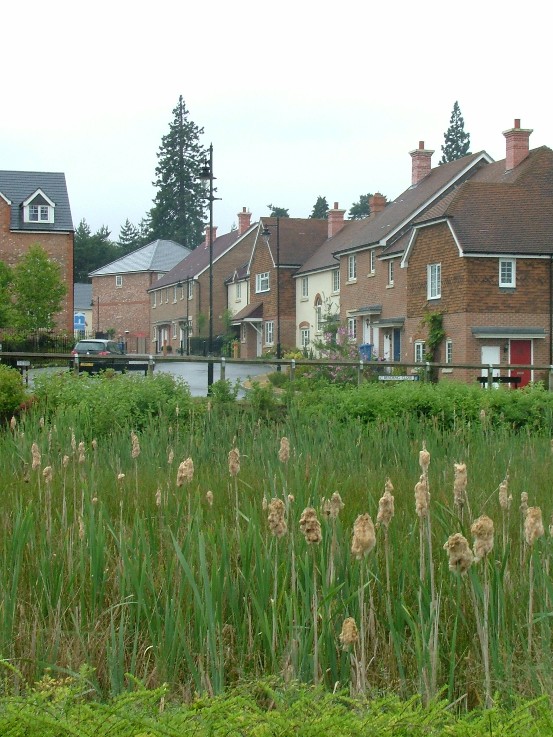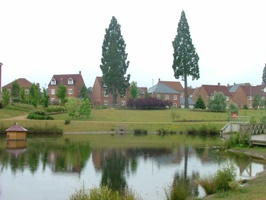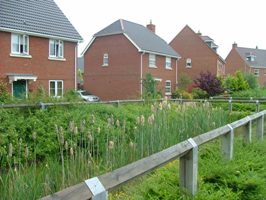Where
Location
Elvetham Heath, Fleet, Hampshire.
Description
63ha of residential development plus ancillary services including a school, village centre, large retail outlet, park and ride and sports pitches. 1868 housing units in total with a mean density of 30 units/ha.
The drainage strategy was to provide soakaway systems to drain the areas of high ground (hence deep groundwater) (approximately one third of the site) and use swales/linear ponds for conveyance in the flattest areas with small detention basins scattered through the site to provide attenuation storage and encourage infiltration to reduce the volume of runoff (approx. two thirds of the site). Standard stormwater pipework was used to drain most of the residential and commercial areas into a retention pond built immediately upstream of the nature reserve. Unlike the basins, the pond was lined.
The detention basins were designed to be relatively shallow and to have an outlet invert level approximately 150mm above the base of the unit. This was done to encourage infiltration.
|
|
|
Figure 1 Elvetham Heath village pond |
SuDS used
Soakaways (for roads and groups of houses), 14 detention basins, 1 pond (lined), and a number of swales/linear ponds.
|
|
|
Figure 2 Detention basin |
How it works
The SUDS scheme is designed to operate within the boundaries of the development with runoff discharging into swales and then into the retention pond giving two levels or stages of treatment. The extent of the management train is variable across the site with some areas draining to swales and detention basins before the final retention pond whist other areas drained directly to the retention pond.
The scheme includes a final retention pond which is surrounded by a park area to form the village pond and will be used for amenity purposes.
In-curtilage options were limited by the high groundwater in some parts of the site although soakaways have been used where possible.
|
|
|
|
Figure 3 Pond providing amenity and a focus for the community |
Figure 4 Swales run through the site providing drainage |
Specific details
The scheme is designed to function to limit discharge to the 50 year return period greenfield rate of 7l/s/ha and to function without flooding up to the 30 year return period event.
An estimated 10% increase in property value for those areas of the development in the vicinity of SuDS components or scheme indicates that the designers may have intended the SuDS scheme to have a tangible benefit in terms of demand for property in the development.
Thames Water has adopted a third of the SuDS scheme with the rest in the process of adoption. As part of the adoption process it was agreed that the developers pay £500,000 to Hart District Council for operation and maintenance of vegetative aspects of the SuDS scheme.
Challenges & lessons learned
A number of challenges were identified:
-
Health and safety was raised as a concern by a homeowner living adjacent to a 2m deep swale with some permanent water. Concern over children gaining access to the swale. The swale was protected with post and rail fencing and thorny hedging plants. An informal survey of other residents indicated this view was not unanimous and most did not see the swale as a problem.
-
There are two main problems associated with the hydraulic performance. The first is that the soakaways serving the higher level roads and residences are not currently performing as expected. Various works have been carried out to enhance their ability to deal with the runoff. The general conclusion is that the process of construction has compressed the soil and affected the ground conditions, reducing its ability to infiltrate the runoff in line with the initial site investigations.
-
The performance of the system was assessed theoretically using the water quality sustainability index developed as part of the Water and New Developments (WaND) project. These indicated a lower than desirable water quality score for all models due mainly to the fact that the system discharges into a sensitive watercourse in a nature reserve and that some roads drain directly into the retention pond hence offering only one level of treatment.
-
Through public consultation, it is evident that there is generally a high regard for the SuDS scheme. Values of properties tend to positively reflect their proximity to the SuDS basins and ponds.







